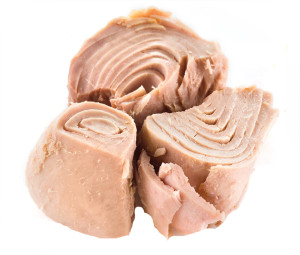Tunas are elongated, robust, and streamlined fishes; they have a rounded body that tapers to a slender tail base and a forked or crescent-shaped tail. In colour, tunas are generally dark above and silvery below, often with an iridescent shine. They have a conspicuous keel on either side of the tail base, a row of small finlets behind dorsal and anal fins, and a corselet of enlarged scales in the shoulder region. Another notable feature is a well-developed network of blood vessels below the skin that acts as a temperature-regulating device associated with long-term, slow swimming.
Tuna is typically gutted by hand, and later pre-cooked for prescribed times of 45 minutes to three hours. The fish are then cleaned and filleted, canned, and sealed. The sealed can is then heated under pressure (called retort cooking) for 2 to 4 hours.This process kills any bacteria, but retains the histamine that can produce rancid flavors. The canned tuna sold in supermarkets or in foodservice outlets, delis, or in tuna sandwiches is either albacore or a mixture of skipjack and yellowfin tuna. “Light tuna” which consists mostly of skipjack and small amounts of yellowfin is the less expensive product. Canned tuna is a good source of essential nutrients, such as omega-3 fatty acids, high quality protein, selenium and Vitamin D.
from Thailand Availability
This product is available all year round.


Nutrition
Average per 100g*- Calories116
- Total Fat1g
- Saturated Fat0g
- Cholesterol30mg
- Sodium50mg
- Total Carbohydrate0g
- Dietary Fiber0g
- Sugars0g
- Protein26g
Storing
15℃

The best temperature for storing canned foods is between 10℃ and 21℃ (50℉ and 70℉)

